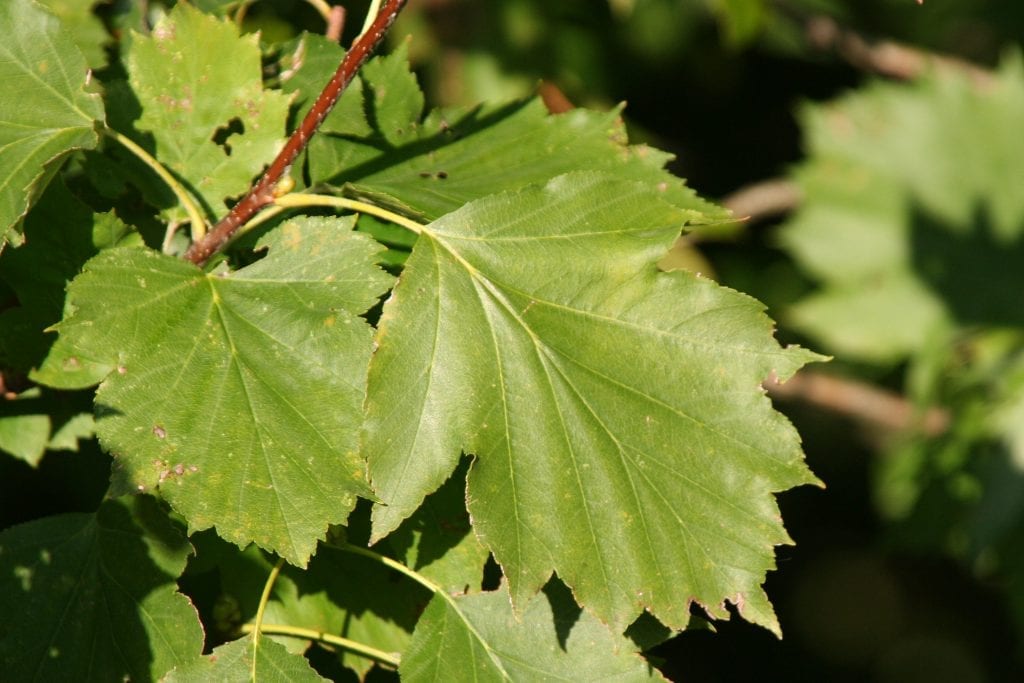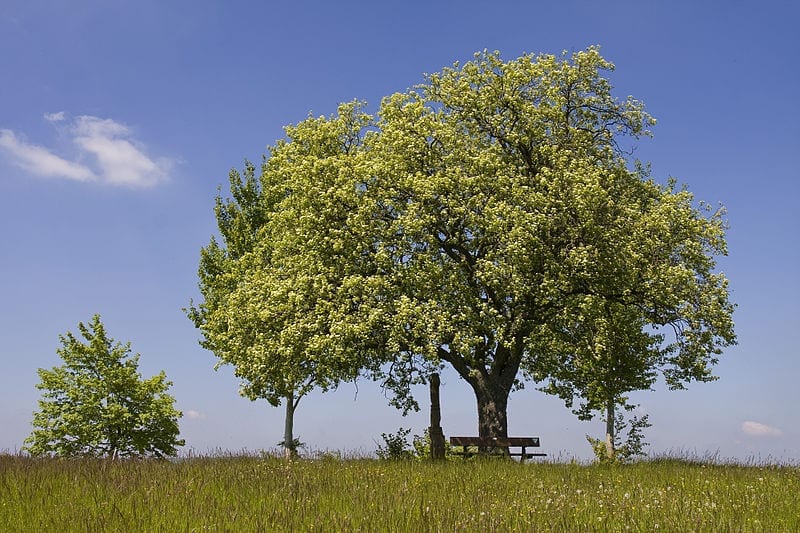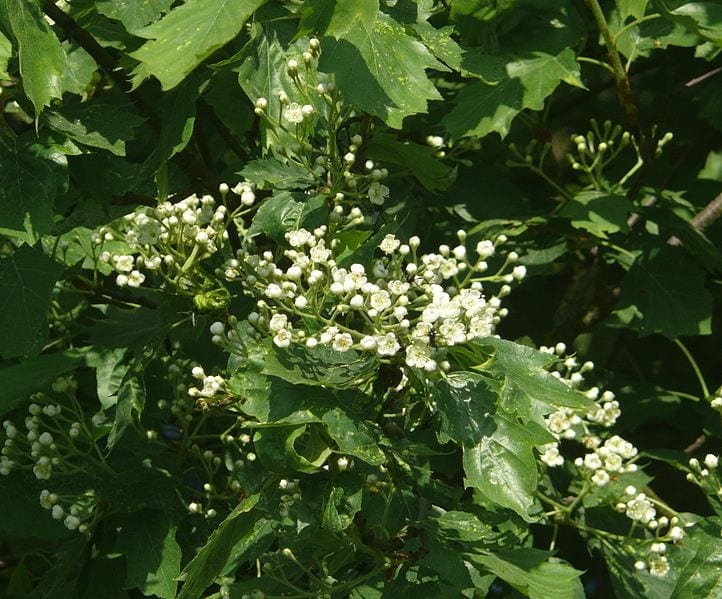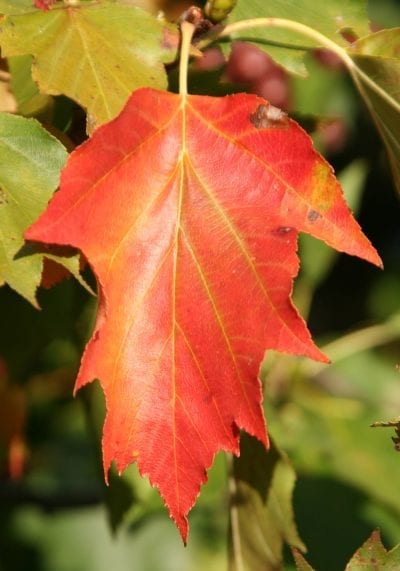
Sorbus torminalis is a very decorative tree, ideal for you to enjoy in a medium or large garden since it is a plant that takes up a lot of space. In addition, it is easy to take care of, since with a little attention it will look great.
So if you are looking for a good size plant that provides good shade, then I will tell you what the characteristics and care of this tree are.
Origin and characteristics

Our protagonist it is a deciduous tree (loses leaves in autumn / winter) native to the Caucasus, northwestern Africa, Turkey, and northern Syria. In Spain we can find it in almost the entire Peninsula except in the southwest. It lives in the forests of oaks, holm oaks, pines and gall oaks. Its scientific name is Sorbus torminalis, although it is known as wild sorbo, wild rowan or mostard.
Reaches a height of up to 25 meters, with a more or less straight grayish-brown trunk that thickens up to 60cm in diameter. The leaves are simple, alternate, with a serrated margin and a very long petiole. These are 5-12cm long by the same width; they have the underside paler than the upper surface, and do not have the dense tomentum of other Sorbus. The flowers, which appear between April and July in the northern hemisphere, are white and small. The ripe fruit is oval, brownish, about the size of an olive.
In many points, such as Portugal and the communities of Valencia, Murcia, Madrid, Extremadura, Castilla y León, Castilla-La Mancha and Andalusia it is protected.
What are their cares?

If you want to have a copy, we recommend that you provide it with the following care:
Location
El Sorbus torminalis it has to be outside, in full sun. It is very important for him to feel the passing of the seasons, the sun's rays, the wind, the rain. Inside the house he would die within a few months.
Earth
- Flower pot: It is not a plant that can be grown in a pot throughout its life, but in its youth it can be with universal cultivation substrate mixed with 30% perlite. You can get the first here and the second here.
- Garden: grows in all types of soils, but prefers fresh, fertile and deep ones.
Irrigation
The frequency of watering will vary greatly as the seasons go by. Thus, while in summer it will be necessary to water more often, the rest of the year irrigation will be more sporadic. So, the best thing to do is to check the humidity of the soil or substrate before proceeding to give water, for example by doing any of these things:
- Using a digital moisture meter: when you enter it, it will tell you instantly what degree of humidity has that soil that has come into contact with the meter. Introduce it again in other areas (further away from the plant or closer) since the soil does not dry out on all sides as quickly.
- Insert a thin wooden stick to the bottom: if when you take it out it comes out practically clean, you can water since the earth will be dry.
- Dig about 5-10cm around the plant: this way you will know how damp the soil really is (and not just the surface, which drying very quickly tends to create a lot of confusion for the gardener).
- Weigh the pot once watered and again after a few days: This can obviously only be done when you are young. Since wet soil weighs more than dry soil, this difference in weight will help you know when to water.
Anyway, to give you more or less an idea, it is recommended to water about 3 times a week in summer and every 5-6 days the rest of the year.
Subscriber

From early spring to late summer it is advisable to pay it with ecological fertilizers, being highly recommended the guano for being organic, very rich in nutrients and of fast effectiveness. You can get it in powder here and liquid (for pot) here.
Multiplication
El Sorbus torminalis multiplies by seeds in autumn (they need to be cold before germinating), following this step by step:
First phase: stratification
Stratification consists of sowing the seeds in an area where they can be cold. It can be natural, sowing them in a pot with universal cultivation substrate and then placing them outside; or artificial, for which you have to do the following:
- First you have to take a tupperware with a lid and fill it with vermiculite (you can get it here) previously moistened.
- The seeds are then placed on the surface, and covered with a layer of vermiculite.
- Finally, sprinkle with copper or sulfur to prevent the appearance of fungi, water it again with a sprayer, and put the closed tupperware in the fridge for three months. Once a week it must be removed and opened so that the air is renewed.
Second phase: sowing
If we have stratified the seeds naturally, we will not have to do anything else; but if we have put them in the fridge, after three months we have to plant them in pots and place them in semi-shade.
They will germinate throughout the spring.
Rusticity
Withstands cold and frost up to -18ºC.
What uses does it have?

Apart from being used as an ornamental, it has other uses:
- Fruits: they are suitable for human consumption.
- Wood: in carpentry and joinery it is used to make pieces that have to suffer prolonged friction.
What did you think of the Sorbus torminalis?